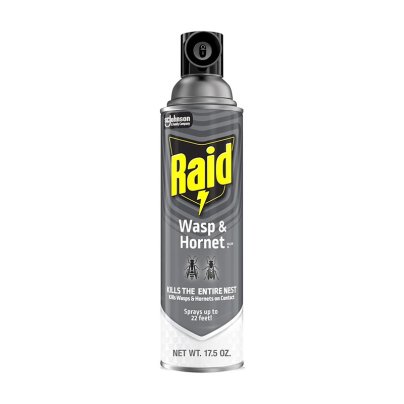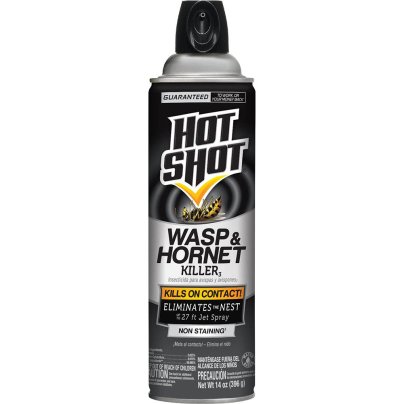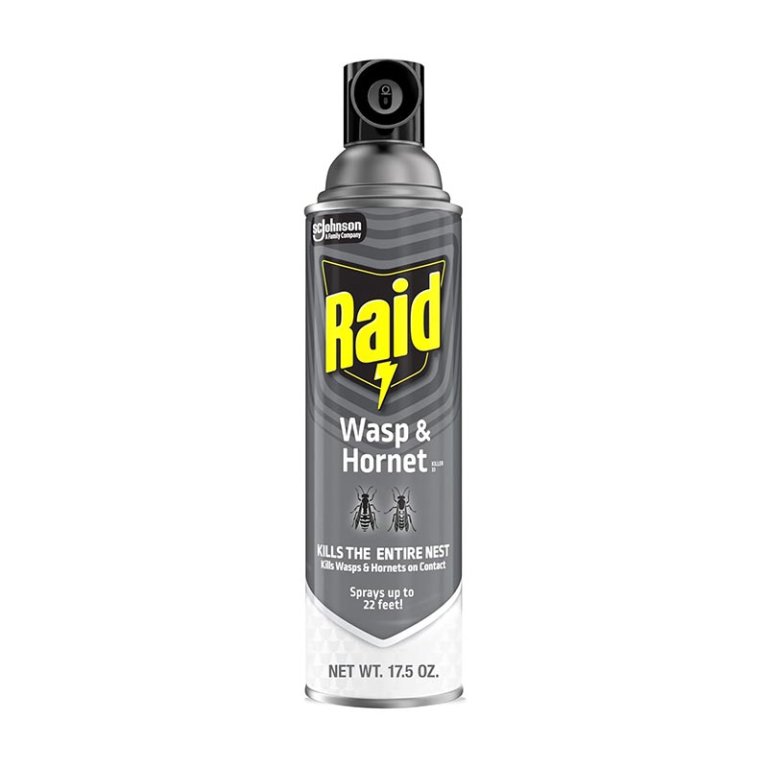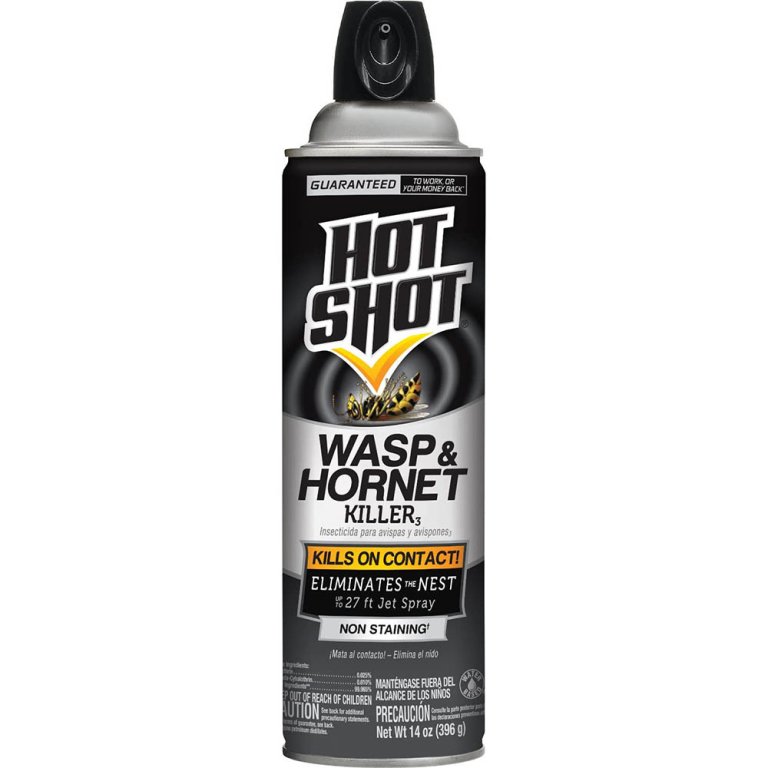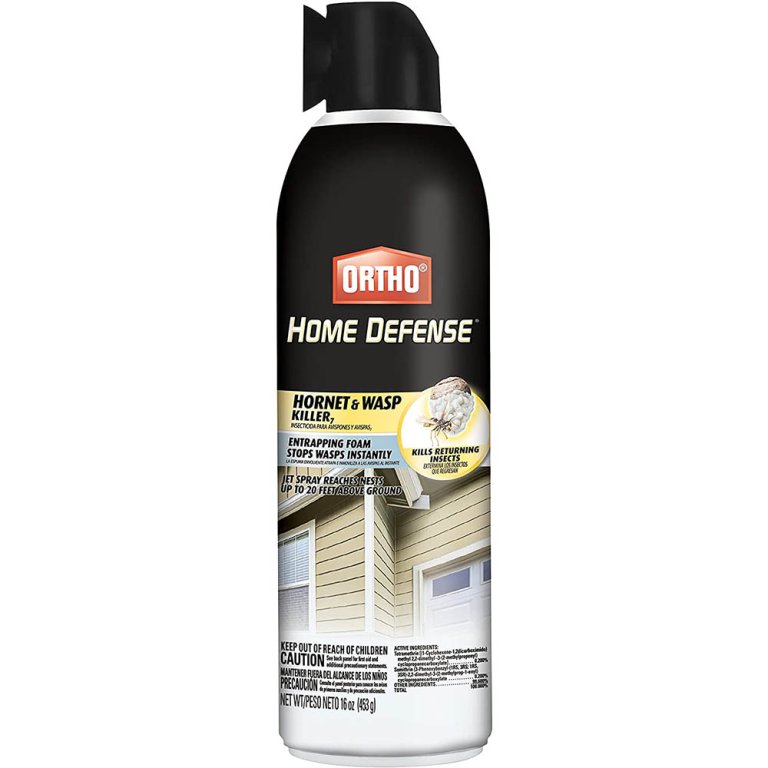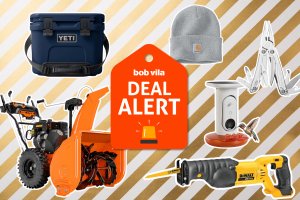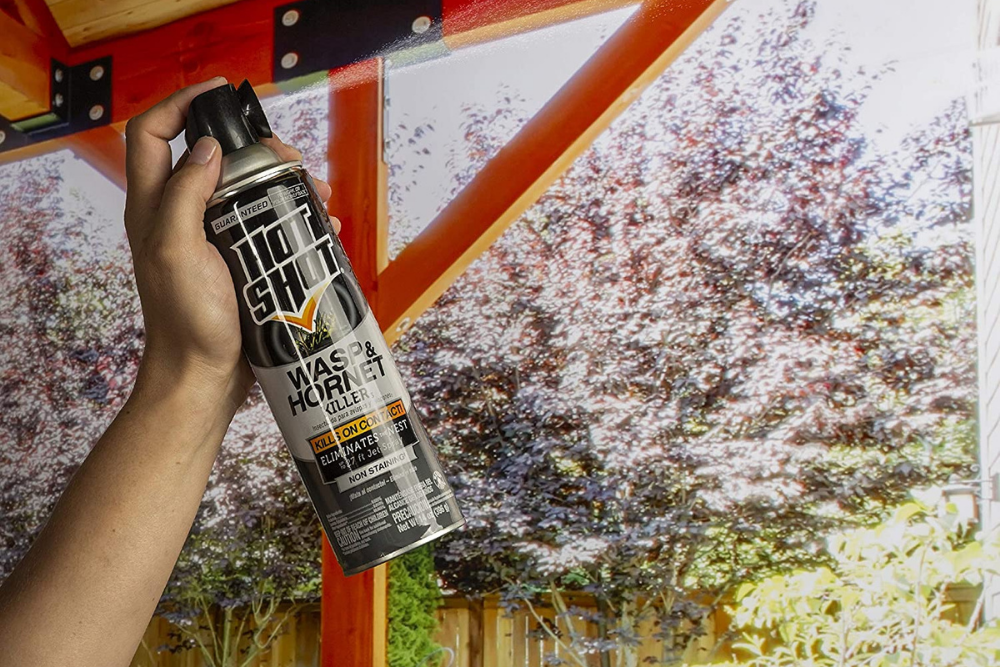
We may earn revenue from the products available on this page and participate in affiliate programs. Learn More ›
If you’re noticing an increasing number of wasps in your outdoor living space, or even your home, it might be time to find an effective wasp spray. Whether these winged pests are hiding between the vinyl in your eaves or building a nest under your covered porch, the right spray can help you put an end to their assault.
Wasp sprays use a blend of neurotoxins that attack a wasp’s nervous system, rendering it paralyzed on contact. These potent pesticides kill on contact and from a safe distance, so you stay out of harm’s way. When sprayed into a nest, they coat the hive, killing wasps returning to the hive hours later.
After researching top wasp sprays on the market for effectiveness and ease of use, we chose the Raid Wasp & Hornet Killer as our top pick. Read on to learn more about it and the rest of the products that made our list, plus details on how to choose between the best wasp sprays available today.
- BEST OVERALL: Raid Wasp & Hornet Killer
↓ Jump to Review - BEST BANG FOR THE BUCK: Spectracide Wasp & Hornet Killer
↓ Jump to Review - BEST LONG-RANGE: Hot Shot Wasp & Hornet Killer
↓ Jump to Review - BEST FOAM: Ortho Home Defense Hornet & Wasp Killer
↓ Jump to Review - BEST CONCENTRATE: Syngenta Demand CS Insecticide
↓ Jump to Review - BEST NATURAL: EcoSmart Wasp & Hornet Killer
↓ Jump to Review

Wasp Sprays Comparison
| Product | Type | Reach | Active Ingredient(s) |
|---|---|---|---|
| Raid Wasp & Hornet Killer | Spray | Up to 22 feet | Prallethrin, cypermethrin |
| Spectracide Wasp & Hornet Killer | Spray | Up to 27 feet | Prallethrin, lambda-cyhalothrin |
| Hot Shot Wasp & Hornet Killer | Spray | Up to 27 feet | Prallethrin, lambda-cyhalothrin |
| Ortho Home Defense Hornet & Wasp Killer | Foam | Up to 20 feet | Tetramethrin, sumithrin |
| Syngenta Demand CS Insecticide | Liquid concentrate | Variable, depends on sprayer | Lambda-cyhalothrin |
| EcoSmart Wasp & Hornet Killer | Spray | Up to 18 feet | Peppermint oil, 2-phenethyl propionate |
Our Top Picks
The insecticides below eliminate wasps from up to 27 feet away, allowing you to remain at a safe distance while they work. Each is designed to kill wasps on contact, and when used regularly, each pick can also act as a wasp prevention spray.
Best Overall
Photo: AmazonWhat We Like
- Spray reaches up to 22 feet
- Effective against multiple stinging insects
- 3-pack provides all-season protection
What We Don’t Like
- For outdoor use only
Specs
- Type: Spray
- Reach: Up to 22 feet
- Active ingredient(s): Prallethrin, cypermethrin
This wasp killer from Raid makes it easy to unleash destruction on wasps’ nests threatening your home while standing at a safe distance. Each 17.5-ounce can delivers an impressive 22-foot range, allowing you to hit high eaves and window casings without having to teeter dangerously on a ladder. You can also target lower-level hives from afar, minimizing the chances of being stung. With 0.05 percent cypermethrin, the formula has a higher concentration of the neurotoxin that kills wasps than most other pesticides, making it incredibly effective.
This Raid wasp killer is available in various multi-pack quantities between one and 12 cans each to ensure you have plenty for season-long treatment of wasps, hornets, and yellow jackets. Its strong scent makes it appropriate for outdoor use only, and the manufacturer recommends spraying in the early morning or evening for best results. Users should also avoid using Raid near sewers and storm drains and on gutters that drain into these areas, as it is toxic to aquatic life.
What our tester says: “Raid’s Wasp and Hornet spray is my go-to choice when I see a wasp’s nest forming. One can of this spray can tackle multiple nests with ease. I also really appreciate the 22-foot range. I’m able to spray any size nest without getting too close to angry wasps or hornets. I have multiple cans of this on hand each summer and it never disappoints. ”—Stephanie Cronk, Executive Editor of Product Reviews
Get the Raid wasp spray (various pack sizes) at Amazon, Lowe’s, Tractor Supply Co., Ace Hardware, The Home Depot, Walmart, or Target.
Best Bang for the Buck
Photo: Lowe’sWhat We Like
- Budget-friendly pricing provides good value
- Substantial spray distance for safety
- Works on wasps and 7 other insects
What We Don’t Like
- May require multiple treatments
Specs
- Type: Spray
- Reach: Up to 27 feet
- Active ingredient(s): Prallethrin, lambda-cyhalothrin
With its ability to kill a whole host of unwelcome visitors, this wasp and hornet spray from Spectracide is an excellent option for budget-friendly pest control. In addition to taking out wasps and hornets, it will also get rid of yellow jackets, carpenter and harvester ants, tent caterpillars, mud daubers, and even the odd scorpion. Designed to be a long-distance wasp spray, it can deliver a stream of wasp-paralyzing poison a maximum distance of 27 feet, allowing you to hit high places without climbing a ladder.
To use, simply coat the entire nest and wait 24 hours for it to kill stragglers returning to the hive. While most colonies fall quickly, larger nests may need a second treatment. The non-staining formula won’t damage siding, so it’s safe to apply under eaves and covered porches, along window casings, and in other nooks and crannies where wasps like to build nests.
Get the Spectracide wasp spray at Lowe’s, Ace Hardware, The Home Depot, Walmart, or Amazon (12-pack only).
Best Long-Range
Photo: AmazonWhat We Like
- Propels up to 27 feet away
- Acts as a preventative wasp spray by killing returning insects
- Won’t stain most siding
What We Don’t Like
- Large nests require a fair bit of product
Specs
- Type: Spray
- Reach: Up to 27 feet
- Active ingredient(s): Prallethrin, lambda-cyhalothrin
Hot Shot’s wasp and hornet killer comes in a 14-ounce can with a jet spray that reaches an impressive 27 feet, allowing you to hit both low and high spots on your home’s exterior without getting too close to hives. In addition to killing on contact, it keeps working for days to come. Any wasps, hornets, yellow jackets, mud daubers, tent caterpillars, or scorpions that aren’t home at the time of treatment will meet their demise upon return.
This formula is designed to be non-staining, though siding age and cleanliness can have an impact, so it’s smart to test a small area first. When targeting the nest, simply aim the narrow stream at the entrance and expand out to cover the whole hive. Like most wasp repellent spray products, Hot Shot is for outdoor use only.
What our tester says: “We had wasps going in and out of a small hole in our siding and nesting under our patio umbrella last summer. I specifically chose Hot Shot for its range and the fact that I didn’t want our light-colored exterior to end up stained. The siding still looks good as new, and I got rid of the wasps without having to go anywhere near them.”—Michelle Larson, Product Reviews tester and writer
Get the Hot Shot wasp spray at Amazon or Walmart.
Best Foam
Ortho Home Defense Hornet & Wasp Killer
Buy at AmazonWhat We Like
- Thick foam traps wasps inside nests
- Sprays up to 20 feet
- Clings to vertical surfaces well
What We Don’t Like
- Can leave residue on some surfaces
Specs
- Type: Foam
- Reach: Up to 20 feet
- Active ingredient(s): Tetramethrin, sumithrin
You don’t need to have perfect aim with this foaming wasp spray from Ortho. The formula expands upon contact, coating nests more thoroughly than a standard spray for wasps. This action makes it easy to kill wasps as they enter, exit, or return later.
Ortho Home Defense reaches up to 20 feet, allowing you to hit doorways, eaves, and windows while staying out of harm’s way. It’s also safe to use as an indoor wasp spray in areas where wasps like to build nests, such as attics. In addition to working on wasps, Home Defense will also take out yellow jackets, mud daubers, and hornets. It comes in a convenient three-pack to provide plenty of coverage for multiple nests or repeat treatments.
Get the Ortho wasp spray at Amazon.
Best Concentrate
Photo: AmazonWhat We Like
- Combats over 30 types of common pests
- Protects for up to 90 days
- Can dilute concentrated formula to desired strength
What We Don’t Like
- Requires mixing and your own sprayer
Specs
- Type: Liquid concentrate
- Reach: Variable, depends on sprayer
- Active ingredient(s): Lambda-cyhalothrin
For those with recurring wasp problems, buying individual spray cans can get expensive and create excess household waste. This concentrated formula from Syngenta, available in 0.8-, 8-, and 32-ounce jugs, lets you mix pesticide as needed to keep wasps, mosquitoes, flies, spiders, fleas, ticks, cockroaches, and dozens of other bugs at bay.
While this pick is both comprehensive and cost-effective, it does have a couple of potential drawbacks. You’ll need to dilute the concentrate with water before use and purchase a sprayer if you don’t already have one. Also, since it’s not an aerosol spray, you won’t get the same long-range propulsion as other products on this list—but you will get long-lasting control for over 30 common pests. Plus, you can dilute it at a rate of between 0.2 and 0.8 fluid ounces per gallon to meet your specific needs.
Get the Syngenta wasp spray (various sizes) at Amazon or Walmart.
Best Eco-Friendly
Photo: Lowe’sWhat We Like
- Safe to use around kids and pets
- Environmentally friendly and biodegradable
- Peppermint oil provides a light, pleasant scent
What We Don’t Like
- Slower kill speed and shorter spray distance
Specs
- Type: Sprayer
- Reach: Up to 22 feet
- Active ingredient(s): Peppermint oil, 2-phenethyl propionate
When you have pets and kids, using pesticides can make you nervous—even when you know getting rid of that growing wasp’s nest under the front porch is urgent. With EcoSmart’s wasp and hornet killer, you get effective pest control without stressing about potential impacts to your family’s health or the environment. Since this insecticide uses peppermint oil and 2-phenethyl propionate (a chemical compound found in foods like guava, peanuts, and certain cheeses) as its primary neurotoxins, it kills insects without harming humans, pets, or wildlife.
While kill speed is generally fast and effective, EcoSmart may not match the immediate knockdown of synthetic chemical sprays. However, like its more aggressive counterparts, it works on more than just wasps, eliminating hornets, yellow jackets, mud daubers, and other flying insects. The jet spray has a reach of up to 18 feet and comes in 9- and 14-ounce cans, sold individually or as a two-pack.
Get the EcoSmart wasp spray (various can sizes and pack sizes) at Lowe’s, Tractor Supply Co., Ace Hardware, The Home Depot, Walmart, or EcoSmart.
Jump to Our Top Picks
What to Consider When Choosing a Wasp Spray
Spraying wasps can be scary business, and not just because there’s always a risk of getting stung. When choosing the best wasp spray for your needs, aspects like safety and ease of use must also be part of the equation.
Types of Wasp Sprays
Wasp killers come in three forms: sprays, foams, and concentrates. Each has advantages and disadvantages that impact tackling nests, whether they’re exposed, hidden, or hard to reach.
Spray
Wasp sprays contain powerful chemicals, including pyrethroids like prallethrin, cypermethrin, lambda-cyhalothrin, tetramethrin, and sumithrin, that rapidly paralyze these defensive insects on contact. This prevents them from retaliating while providing residual protection against their return.
Sprays usually come in aerosol cans, which lets you stand a reasonably safe distance of up to 27 feet away. As wasps tend to make their nests in the eaves of homes, this long range also allows you to reach the nest without having to use a ladder, which could be dangerous should you need to make a hasty retreat.
Of course, blasting a nest from 27 feet away takes some skill. The further away you are, the harder it is to aim the spray accurately, causing waste or, worse, leaving enough wasps alive to mount a counterattack.
A thorough approach works best when using a spray, meaning a few spurts won’t be enough. Keep the nozzle depressed and coat the entire nest to ensure all wasps are disabled to prevent any from retaliating or escaping to build a hive in some other location near your home.
Aerosol Foam
Aerosol foam sprays work similarly to standard sprays, only the liquid creates a foam on contact, trapping wasps and paralyzing them with chemicals. The foam expands after it hits a nest, increasing the pesticide’s coverage and ensuring fewer wasps escape. While aerosol foams provide better coverage than standard sprays, they generally have shorter ranges of up to 20 feet.
Liquid Concentrate
For smaller problems, a simple can of spray or aerosol foam will get the job done. Unfortunately, wasps can be persistent pests, returning to make nests in various nooks and crannies around your home’s exterior. If you have a recurring wasp problem, you may need a larger supply of wasp killer to keep the wasps at bay.
Since even a relatively small bottle of liquid concentrate will typically make several gallons of spray, concentrates offer a much better value than the spray-ready products. They’re also typically effective against a broader range of insects, allowing you to take out ants, roaches, and a whole host of other pests.
Concentrates do have their downsides, including requiring mixing to a properly diluted level and supplying your own sprayer. Because they don’t come compressed in cans, they also won’t have the same range as aerosol products, meaning you’ll need to stand much closer to the nest during application, which makes you more vulnerable to stings.
Residual Action
Residual action is how long a wasp spray keeps killing after initial application. The best wasp sprays are pyrethroid-based, and their chemical formulas leave a protective residue on nests and surrounding surfaces that can remain effective for days or weeks. Some concentrated formulas may even work for up to 3 months. Since both rain and sun can shorten residual effectiveness, periodic reapplication may be necessary for ongoing protection.
Safety
Safety considerations are twofold when it comes to dealing with wasps. Not only can the products themselves be toxic, but spraying hives can also provoke an aggressive response.
Choose products with clear instructions and use them during early morning or late evening when wasps are less active. Always wear protective clothing, including gloves and safety glasses, and avoid inhaling spray. If you have kids or pets, consider nontoxic or natural sprays if you have children or pets. No matter which product you use, keep it away from food, water sources, and open wounds to protect your family and the environment.
FAQs
If you’re wondering how you should use wasp spray, how these products kill insects, or whether they’re harmful to humans, read on for answers.
Use the following steps to put an end to the wasps invading your home:
Wait until sunset. While this may sound dramatic, it’s actually strategic. These insects are least active at dusk, meaning most of the wasp population will be in the hive, maximizing your ability to eliminate all its inhabitants.
Stand safely away from the nest. Wasp sprays are designed with ranges of 15 to 27 feet for a reason. When you spray the hive, the wasps will attempt to counterattack. The farther you are from the hive, the safer it is for you. It’s also important not to stand under the nest, as the spray can run off and fall to the ground along with any six-legged casualties.
Soak the nest. Don’t be stingy with the spray. Dousing the nest will ensure that you kill all the wasps, preventing them from coming after you. A nest soaked with pesticide will also take care of any inhabitants that return to the hive later.
Wait 24 hours. Even if you plan your attack at sunset, it’s unlikely every wasp will be at home. Wait 24 hours before removing the nest to allow the pesticide to kill any wasps returning to the hive.
Dispose of the nest. Remember that most pesticides are hazardous to humans and pets. Wear gloves and a mask when removing a wasp nest. Make sure to put the nest in an enclosed garbage can to prevent pets and children from coming into contact with it.
Wasp sprays use chemicals known as pyrethroids and pyrethrins, both of which cause catastrophic damage to the wasp’s nervous system on contact, paralyzing and killing them, which causes them to drop out of the air instantly after being sprayed.
Yes, wasp spray is dangerous to humans. The National Pesticide Information Center warns that brief direct exposure can cause symptoms like difficulty breathing, headaches, dizziness, nausea, vomiting, abdominal pain, itching, or burning. Always use caution to avoid skin or eye contact, and do not inhale or ingest wasp spray. If an accident happens, contact a Poison Control Center or seek emergency medical help immediately.
If you aren’t dealing with an established nest and want to repel wasps with something much less dangerous, you can make a homemade wasp spray using vinegar and other natural ingredients. Since wasps don’t like the smell, spraying a mix of equal parts water and vinegar can help deter them, though it won’t kill them.
Wasps are generally more aggressive in late summer to early fall, from August to September. This is when their nests are the largest, but food starts to become more scarce. Workers wasps naturally become more defensive of the colony, making them more likely to sting.
The main differences between a wasp versus a hornet are size, color, and behavior. While hornets are simply a specific type of wasp, they are generally larger and have black and white or brownish coloration rather than standard wasps’ black and yellow stripes. And while hornets build large, enclosed paper nests in trees or bushes, wasps prefer nests in sheltered spots. Hornets are also more aggressive and have a more painful sting.
You should not disturb wasps or attempt to remove their nests during the day when they’re most active. Don’t stand too close when using a wasp spray, and don’t try to get rid of their nest using fire or water.
